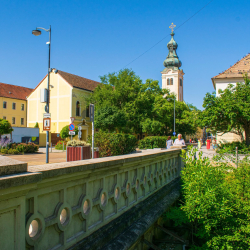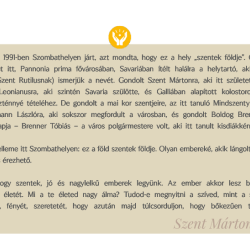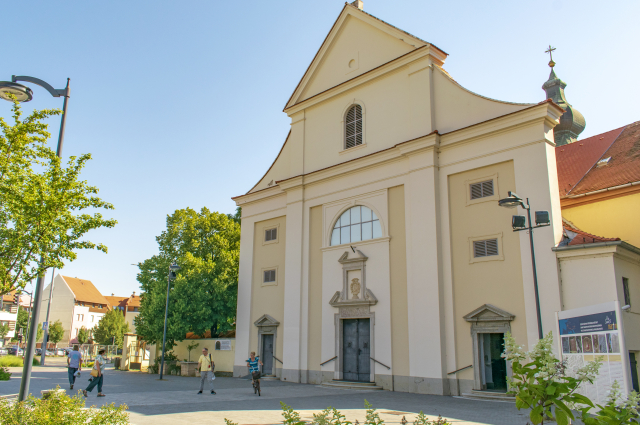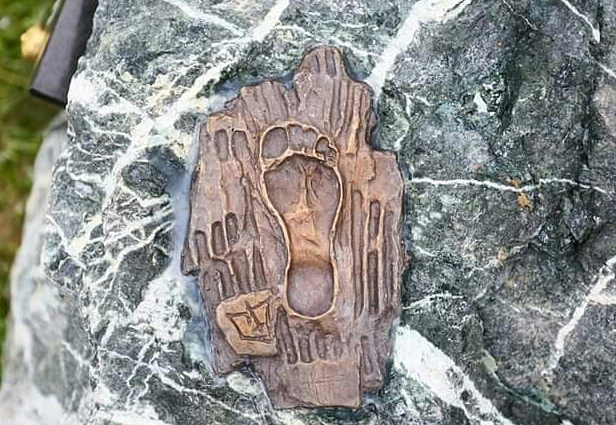
(Day 7) Kőszeg - Szombathely

Our journey is slowly coming to an end. Walking through the tranquil, quiet streets of Kőszeg, we find the footprints of St. Martin, where, according to legend, he came when there was a disaster, and he appeared there to the give aid of the townspeople. Leaving for Saint Martin's birthplace in Szombathely, a small adventure awaits us through the vineyards and forest. The last story of those seven days, is perhaps the most important part of our trip. From the Church of Calvary to the Church of St. Martin, we are guided by the yellow signposts of the Via Sancti Martini road, from early Christian traditions through the important events of Martin's life to works of art honouring the Saint.
It is worth starting the day in Main Square (Fő tér), the centre of community life, where the terraces of cafes and restaurants provide an excellent place for a good breakfast. Our attention is drawn to the church with its 57-metre-high tower, this is the parish church of the Heart of Jesus, built-in 1894. Similar to the external appearance of the church, it is accompanied by a harmonious neo-Gothic interior. The medieval and baroque houses give the city centre its extraordinary atmosphere, Jurisics Square, the Castle, churches and museums take us back to the time of the former free royal city of Kőszeg.
Following the route, we arrive at the small park, at the footprints of St. Martin. According to the legend, St. Martin appeared here and rushed to help the townspeople: During the Turkish siege in 1532, the defenders of the castle were helped by St. Martin appearing on his horse in addition to their heroic determination.
LEGEND
“It is said that a horseman of great stature and imposing appearance appeared to rush out of the castle with shining weapons, bringing with him many soldiers to help the struggling townspeople. This created such unusual fear and terror within the Turks that they retreated from the walls in a headlong run. Many of the townspeople saw it in the same way, and explained that their patron saint, St. Martin, appeared at the right moment to bring help to the besieged and to restore his courage." (Miklós Istvánffy)
At 11 o'clock we can hear the sound of the bells, which breaks the silence of the streets of Kőszeg every day. It keeps a memory! But what is it?
Kőszeg
Spiritual provision
 |
Miklós Jurisics was fighting, defending the castle with barely 50 soldiers and approx. 700 peasants. He knew that he could not win, he only wanted to slow down the Turkish army that was trying to reach Vienna. This is what the defenders decided to do, even at the cost of their lives if necessary. Hungary - and Croatia, which fought together with us - was the shield of Christianity for centuries. With blood, life sacrifice, courage and tears, she protected her children and women, she protected life, faith, the treasures of the mother tongue and motherland.
We can still be the shield of Christianity today. Today, a peculiar flood is attacking the values of God, the family, the nation, the motherland and the communities, this fivefold, natural, life-giving root system. We must build arks in this flood. Every good family full of love, loyalty and faith is such a Noah's ark. Noah's ark is every good school where bad language is not yet fashionable, laziness and pretentiousness, stupidity and immorality are not fashionable. Build arks as Miklós Jurisics did! |
Footprint of Saint Martin |
We leave Kőszeg on a bicycle path, in the direction of Kőszegfalva, the beautiful natural environment and view of Lake Abért welcomes us. Riding south, through villages, we arrive at Luckácsháza. Our path leads through a cozy vineyard hill to the Csömöte lookout, where a stone compass shows where to go next.
Just before we arrive to Szombathely, in Gyöngyösfalu, there has always been a church dedicated to St. Martin. Today's church, rebuilt in 1905, is beautiful inside and out, and there are benches nearby where you can have a short rest. It preserves the stone carvings of the church built in the 1400s, which formed the border of two settlements with engineering precision. It created the special situation that in every Mass the epistle was said to the faithful in Nagypös and the gospel in Kispös. The figure of St. Martin can be found both on the altarpiece and on the glass windows. From here, we will soon arrive at the destination of our pilgrimage; Szombathely, the birthplace of St. Martin.
This is the last story of the seven days, perhaps the most important part of our trip. During our short trip, we travel back in time, back to 316, when the city was called Savaria, which was part of the Roman province of Pannonia. From the Church of Calvary to the Church of St. Martin, we are guided by the yellow signposts of the Via Sancti Martini road, from early Christian traditions through the important events of Martin's life to works of art honouring the Saint. In the courtyard of the Savaria Museum, the legendary geese cross our path, we are no longer betrayed by their cackling (they are stone statues), unlike Martin, who was forced to bow to the will of the people, and he became the bishop of Tours. In the cathedral, you can find the herm of the saint, which keeps its skull relic to this day.
At the final stop of our pilgrimage, above the entrance to St. Martin's Church, we find the following inscription: "Hic natus est St. Martinus" i.e. " St. Martin was born here. "
Szombathely
Spiritual provision
 |
When Pope John Paul II visited Szombathely in 1991, he said that this place had been the "land of the saints". He meant the countless early Christian martyrs, of whom we only know the names of a few (such as St. Quirinus and St. Rutilus), who were sentenced to death by the governor here in Savaria, the capital of Pannonia prima. He was thinking of Saint Martin, who was born here, whose father was a soldier here. He thought of Saint Leonianus, who had also been born in Savaria and founded monasteries in Gaul, contributing decisively to the Christianization of Burgundy. But he was thinking of the saints of today, Cardinal Mindszenty who studied here, László Boldog Batthyány-Strattmann who lived nearby, who visited the city many times, and he thought of the martyr János Brenner beatified, who was born here, whose grandfather - Tóbiás Brenner - was the mayor of the city, who studied here as a junior student and then as a secondary grammar school student.
This is the genius loci, the spirit of the place here in Szombathely: this land is the land of saints. It belongs to people who have been blazing and shining, whose radiating presence is still being felt today.
We were born to be holy, good and generous people, too. A person will be happy if he succeeds in giving and making his life a gift. What is your big dream in life? Can you open your heart, as the saints did, to let in the beauty, light, and love of God, so that it will then overflow so that you can generously pass it on to others? |
The place of birth of Saint Martin |
- Duration: 1 hour(s)
- Length: 21,2 km
- Difficulty: Easy
| Area: | Velo Martini |
| Típus: | Cycling routes |
Szolgáltatás Stop point
Stop point - Szombathely
SzombathelyThe people of Szombathely are particularly close to the person of Saint Martin. Above the entrance to the chapel of the church...
MoreStop point- Kőszeg - Church of the Heart of Jesus
Kőszeg - Jézus szíve templomThe Parish Church of the Heart of Jesus stands in the historic centre of Kőszeg, where the Castle Circle and the market square...
MoreStop point - Lukácsháza
LukácsházaToday's Lukácsháza consists of three formerly independent villages (Nagycsömöte, Kiscsömöte, Lukácsháza).
MoreStop point - Kőszegdoroszló
KőszegdoroszlóThe church of St Martin is probably of Romanesque origin, but the exact date of its construction is unknown. It was used for a...
MorePoint of interest - Kőszeg - Bronze footprint of Saint Martin
Kőszeg - Szent Márton Bronz lábnyomaIn November 2019, the St. Martin Memorial was inaugurated next to the St. Martin tree in Hunyadi Mátyás Park in Kőszeg. King...
MorePoint of interest - Gencsapáti - Devil's stone
Gencsapáti - ÖrdögkőThe Ördögkő is a fragment of a Roman column that has stood on its present site since 1907. Its original location is uncertain....
MoreVelem - St Vid Chapel
Velem - Szent Vid kápolnaIn the Bronze Age, the site of the chapel of St Vid was the site of an extensive and important town, with houses built on...
MoreRailway Station - Lukácsháza I.
Lukácsháza - felsőAddress: 9724, Lukácsháza Kőszegi street 28.
More





























